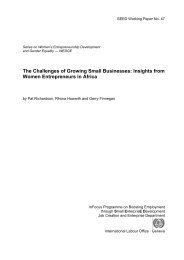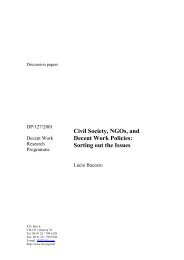manual: women workers' rights and gender equality - International ...
manual: women workers' rights and gender equality - International ...
manual: women workers' rights and gender equality - International ...
Create successful ePaper yourself
Turn your PDF publications into a flip-book with our unique Google optimized e-Paper software.
No child should have to work No child should be sexually abused Children can choose their own friends<br />
(picture No. 44) (picture No. 45) (picture No. 46)<br />
Exercise - Children<br />
Step 1<br />
• When organizing a session with children, make sure it does not conflict with school timings.<br />
• H<strong>and</strong>out paper <strong>and</strong> pencils <strong>and</strong> ask the children to make two drawings. One drawing about<br />
what they like <strong>and</strong> one about what they do not like about being a child (working, playing,<br />
going to school or not going to school etc.).<br />
• They should not put their name on the drawings.<br />
• After 30 minutes ask the children one by one to present their drawings <strong>and</strong> let them explain<br />
their drawing <strong>and</strong> why they like or do not like what they have drawn.<br />
Step 2<br />
• Ask the children if they know what kind of <strong>rights</strong> they have.<br />
• If they mention one, check if there is a card representing the issue <strong>and</strong> put it at a place where<br />
everyone can see it. When the children do not come up with more child <strong>rights</strong> but you still have<br />
some cards in your h<strong>and</strong>, show them one by one to the group <strong>and</strong> explain the right on the<br />
drawing.<br />
• Discuss the <strong>rights</strong> briefly with the children, using the following questions:<br />
- Do they know about these <strong>rights</strong>?<br />
- Do they enjoy all the <strong>rights</strong>?<br />
- If not, do they know reasons why they do not enjoy these <strong>rights</strong>?<br />
- What can they do when someone is violating one of their <strong>rights</strong>?<br />
Step 3<br />
• Summarize the discussion <strong>and</strong> mention once more the <strong>rights</strong> children have.<br />
Exercise - Adults<br />
Step 1<br />
• Start the session with the question if the participants know what <strong>rights</strong> a child has.<br />
• If they mention one, check if there is a card representing the issue <strong>and</strong> put it at a place where<br />
everyone can see it. When they do not come up with more child <strong>rights</strong> but you still have some<br />
cards in your h<strong>and</strong>, show them one by one to the group <strong>and</strong> explain the right on the drawing.<br />
Step 2<br />
• Divide the group into 4 small groups. Give each group a set of drawings made by the children.<br />
• Ask them to have a look at the drawings <strong>and</strong> group them into two: good situations <strong>and</strong> bad or<br />
sad situations.<br />
• Let each group present the drawings in plenary <strong>and</strong> hang the drawings at a place where<br />
everyone can easily see them. The drawings showing good situations under a happy face <strong>and</strong><br />
the drawings with bad or sad situations under a sad face.<br />
69

















